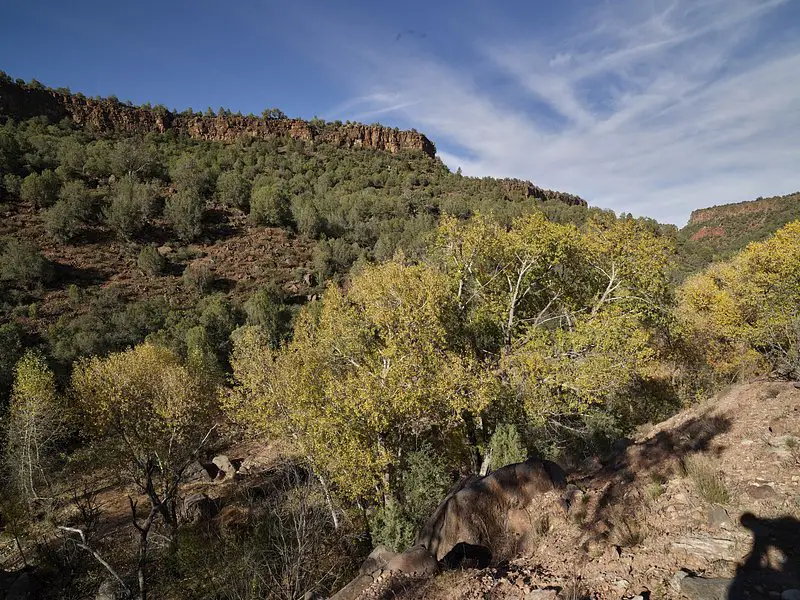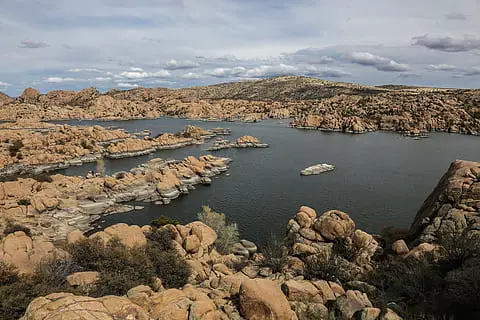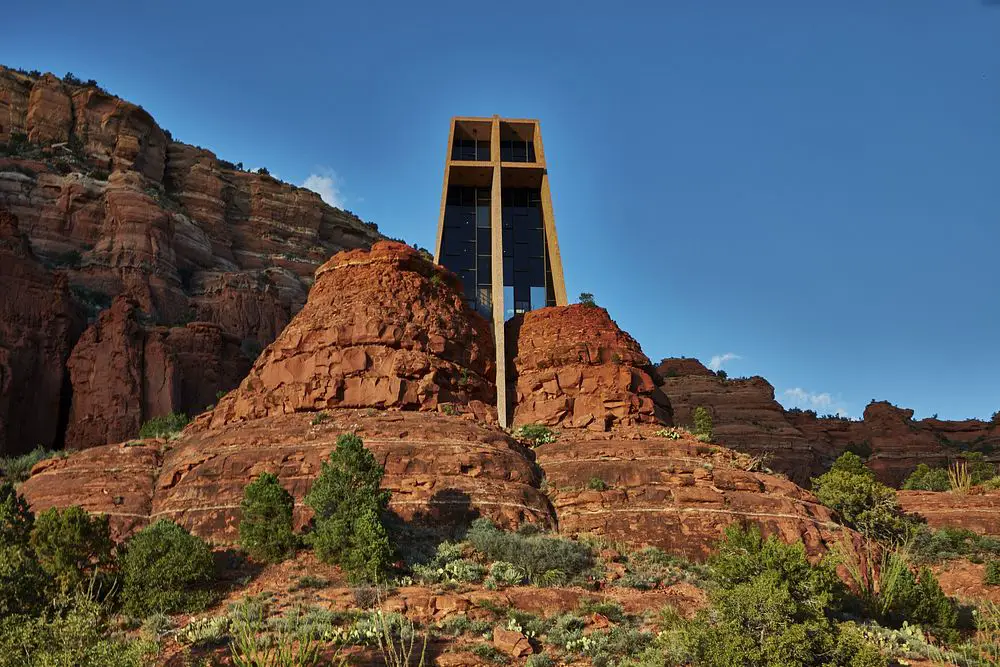Nestled in the heart of Arizona, the Prescott area boasts some of the country’s most scenic natural landmarks. A place where nature’s majesty meets adventurous spirits, it’s no wonder that these landmarks are among the most visited in the state.

As we dive into the beauty of these treasures, let’s explore the reasons why these spots in the Prescott area have become must-visit destinations for nature enthusiasts and travelers alike.
The Historic Granite Dells
Encompassing a vast expanse of rugged beauty, the Granite Dells are a stunning geological marvel. Sculpted over eons by the forces of nature, these ancient rock formations stand as a testament to the enduring power of the natural world.
- Formation and Geological Significance: The Granite Dells, characterized by their distinctive granite boulders, took shape nearly 1.4 billion years ago. These formations underwent extensive weathering, resulting in the intriguing shapes and textures we see today. With such ancient roots, they offer a unique window into the Earth’s geological past.
- Activities: Hiking, Climbing, and Kayaking: For outdoor enthusiasts, the Dells present a haven. Numerous trails wind through this area, offering various difficulty levels for hikers. Climbers find the rugged surfaces perfect for testing their skills. Additionally, the serene waters that wind through these rocks offer excellent kayaking experiences, providing a water-based perspective of this natural wonder.
Watson Lake
Emerging as a shimmering oasis amidst the granite expanse, Watson Lake is a delightful juxtaposition of azure waters against the rough backdrop.
- The Captivating Blue Waters Contrasted with Granite Dells: Watson Lake’s placid waters offer a mesmerizing contrast to the surrounding Granite Dells. It’s this dramatic visual contrast that draws photographers and artists to its shores, seeking to capture its unparalleled beauty.
- Boating and Fishing Adventures: Apart from its aesthetic appeal, Watson Lake is a hub for recreational activities. With a variety of fish species, it’s a popular spot for anglers. Boating enthusiasts can navigate its waters, taking in the panoramic views of the Dells from a unique vantage point.
Goldwater Lake
Situated just a short drive from downtown Prescott, Goldwater Lake is a serene escape, offering visitors a chance to commune with nature in a tranquil setting.
- History and Establishment: Named after Morris Goldwater, a significant figure in Prescott’s history, the lake was developed as a reservoir to meet the area’s growing water needs. Over time, its shores became a favored spot for locals and tourists alike.
- Picnicking and Trails for Visitors: The tree-lined shores of Goldwater Lake provide the perfect setting for picnics. For those looking to stretch their legs, the lake is surrounded by multiple trails suitable for both beginners and experienced hikers. It’s an ideal location for a day out in nature, offering both relaxation and adventure.
Thumb Butte
Rising proudly above Prescott’s skyline, Thumb Butte is not just a natural landmark but also a symbol of the area’s rich history and culture.
- The Iconic Silhouette and its Significance to Prescott: Thumb Butte’s unmistakable profile is easily recognizable. Its significance isn’t just geological; it holds cultural importance for Prescott’s indigenous peoples and has become an emblem of the city itself.
- Trails and Viewing Points: A hike up Thumb Butte is rewarding, with panoramic views awaiting those who reach its summit. Different trails cater to varying fitness levels, ensuring everyone can enjoy the experience. The viewing points along the way offer breathtaking vistas of Prescott and the surrounding landscape.
Prescott National Forest
An expansive haven of biodiversity, the Prescott National Forest stretches over a vast area, offering diverse terrains from woodlands to grasslands.

- Vast Expansiveness and Biodiversity: Home to a myriad of plant and animal species, this national forest is a bio-rich region. Its diverse habitats support creatures like the Mexican spotted owl, among other endangered species.
- Camping and Hiking Opportunities: For the intrepid traveler, the Prescott National Forest offers countless opportunities. There are numerous camping spots where visitors can immerse themselves in the wilderness. The trails here range from easy walks to challenging hikes, catering to all.
Lynx Lake Recreation Area
Lynx Lake offers a blend of serene beauty and recreational opportunities. Its shores, reflecting the surrounding landscapes, are a sight to behold.
Scenic Beauty of the Lynx Lake: A gem in the heart of Prescott, Lynx Lake’s calm waters mirror the lush forests and hills that envelop it, creating a picturesque setting.
Activities: Fishing, Hiking, and Bird Watching: With its abundant fish population, Lynx Lake attracts anglers year-round. The surrounding areas offer diverse trails, ideal for hikers. Moreover, the region is a hotspot for birdwatchers, with many species making it their home.
Willow Lake
Willow Lake stands as another of Prescott’s mesmerizing geological wonders. The formation process of this lake and its surroundings offers a tale of nature’s relentless creativity and dynamism.
- Geological Wonders and Formation: Willow Lake, much like its counterpart Watson Lake, is characterized by its surrounding granite boulders. These massive rocks, which began forming roughly 1.4 billion years ago, underwent significant erosion due to water and wind, leading to the spectacular formations seen today. The lake itself fills depressions among these granite formations, creating a scene straight out of a fantasy novel.
- The Intricate Trail System: Willow Lake isn’t just for those looking to admire the view from a distance. A complex system of trails winds around the lake, providing hikers of various expertise levels a chance to immerse themselves in this stunning landscape. Each trail offers a unique perspective, ensuring a fresh experience with every trek.
Peavine National Recreation Trail
Peavine Trail, with its historic roots, offers not just a trek but a journey back in time.

- History and Origin of the Trail Name: The Peavine Trail gets its unique name from the old Santa Fe, Prescott, and Phoenix Railway. Often called the “Peavine” because of its winding nature, this trail traces back the same routes once taken by the historic trains, turning every step into a piece of history.
- Wildlife and Scenic Views: Along the trail, visitors are treated to an array of fauna and enchanting vistas of the Watson and Willow Lakes. Birdwatchers, in particular, are in for a treat as the trail is home to a myriad of bird species.
Spruce Mountain Lookout Tower
Perched atop Spruce Mountain, this tower offers an elevated view of the Prescott area like no other.
- Historical Significance: Built originally as an essential tool for spotting forest fires, the Spruce Mountain Lookout Tower has since become an iconic structure. It stands as a testament to the region’s commitment to preserving its natural beauty.
- Panoramic Views of the Prescott Area: Those willing to ascend the tower are rewarded with panoramic vistas of the entire region. From this vantage point, many of Prescott’s natural landmarks can be seen, painting a cohesive picture of the area’s diverse landscape.
Granite Mountain Wilderness Area
This wilderness region showcases nature in its rawest form, offering experiences that are both challenging and deeply rewarding.
- The Rugged Terrains and Unique Ecosystem: Granite Mountain Wilderness Area is a haven for biodiversity. Its varied terrains, from craggy outcrops to dense forests, support a unique blend of flora and fauna. This region offers a glimpse into nature’s unspoiled and untamed.
- Guided Tours and Safety Measures: Due to the challenging nature of some trails, guided tours are available to help navigate this wilderness. These tours also provide insights into the area’s ecology, geology, and history. Moreover, there are specific safety measures in place to ensure the well-being of every adventurer.
Mingus Mountain
Mingus Mountain stands tall, offering unique experiences both on its slopes and in the skies above.
Elevations and Unique Vistas: At its highest point, Mingus Mountain offers unparalleled views of the Verde Valley, the Red Rocks of Sedona, and even the San Francisco Peaks in the distance.
Hang Gliding and Other Attractions: Mingus Mountain isn’t just for hikers. Its elevations make it a popular spot for hang gliding, with enthusiasts soaring above the valleys, taking in the landscape from a bird’s-eye view.
Hassayampa River Preserve
Hidden in the heart of Arizona, the Hassayampa River Preserve is a true natural gem, offering a unique juxtaposition of desert landscapes with the cool waters of a river.
- The Rarity of a Desert River: The Hassayampa River, unlike many in the Arizona region, flows mostly undisturbed for much of its length. Its name, derived from the Native American language, translates to “water that flows upside down,” referencing its subterranean flow in certain sections.
- Flora and Fauna Sightings: This oasis amidst the desert is a biodiversity hotspot. From majestic cottonwood and willow trees to a plethora of bird species, including the vermilion flycatcher and black hawk, this preserve is a paradise for nature lovers and birdwatchers.
Granite Basin Lake
Nestled against a backdrop of mountains and boulders, Granite Basin Lake promises tranquility and recreational adventures.
- The Serene Atmosphere and Backdrop: The reflections of the surrounding rocky outcrops on the lake’s calm waters create a picturesque scene, making it a favorite spot for photographers and nature enthusiasts alike.
- Activities: Horseback Riding and Mountain Biking: Beyond its visual appeal, Granite Basin Lake offers a range of activities. Equestrian trails are popular here, with riders often seen exploring the surroundings. Mountain biking trails also abound, catering to both novices and experts.

Highlands Center for Natural History
Where education meets nature, the Highlands Center for Natural History is a beacon for those eager to learn about Prescott’s diverse ecosystems.
- A Blend of Education and Nature: This center offers an amalgamation of structured learning programs and the raw beauty of nature. With its outdoor classrooms, nature trails, and observatory, it’s a hub for environmental education.
- Programs and Activities for Children and Adults: Catering to all ages, the Highlands Center hosts numerous events, workshops, and programs. From summer camps for kids to specialized workshops for adults, there’s always something happening here.
Verde River Greenway
Spanning over 36 miles, the Verde River Greenway boasts lush riparian habitats, making it one of the region’s greenest spots.
- The Lush Riparian Habitat: This habitat is home to a myriad of plant species, some of which are endemic to the region. Cottonwoods, sycamores, and mesquite trees line the riverbanks, creating a serene atmosphere.
- River Adventures and Birdwatching Spots: Adventure seekers can engage in kayaking and canoeing, while birdwatchers might spot kingfishers, herons, and eagles.
FAQs:
In this section, we will be delving into some of the most common inquiries and curiosities that surround our topic.
Which landmarks are best visited during specific seasons?
While most landmarks in Prescott are accessible year-round, some like the Prescott National Forest are especially enchanting in the fall, showcasing vibrant autumn hues.
Are there any restrictions or guidelines for specific landmarks?
Yes, some areas, especially protected ones, have guidelines to ensure the safety of both visitors and the environment. Always check official websites for updated information.
Which landmarks are most suitable for families with children?
Locations like Goldwater Lake and Lynx Lake Recreation Area are family-friendly with activities suitable for all age groups.
How can visitors contribute to the preservation of these landmarks?
By adhering to ‘Leave No Trace’ principles, respecting local guidelines, and considering donations to local conservation organizations.
Which landmarks offer guided tours or educational programs?
The Highlands Center for Natural History often provides educational programs and guided tours for visitors.
Summary
The Prescott area, with its vast natural wonders, invites visitors to step into a world of unparalleled beauty. From the rugged charm of the Granite Dells to the serene waters of Watson Lake, each landmark tells a unique story.
As we cherish these natural treasures, it’s essential to remember our responsibility in preserving them for future generations. In this endeavor, sustainable tourism plays a crucial role. Embracing these landmarks not just as sightseeing spots but as integral parts of our natural heritage is the key to ensuring their longevity.



Leave a Comment
You must be logged in to post a comment.